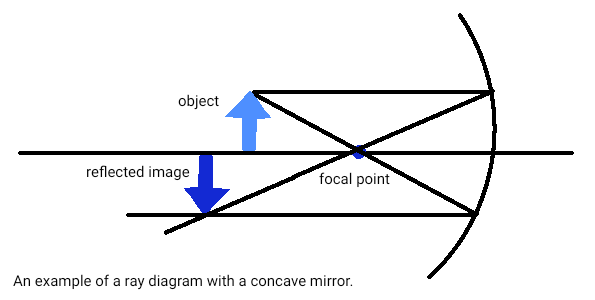Unit 6: Optics
Concepts
Waves - Waves have a frequency, which is the number of wave cycles per second, and a period, which is the time that one wave cycle takes. Certain waves, such as sound waves, are referred to as mechanical, which means they need some kind of medium to travel. Electromagnetic waves such as light, on the other hand, don't need a medium to travel. This means they can also travel through vacuums.
Electromagnetism spectrum - The range of electromagnetic radiation. The spectrum goes from low frequency/long wavelengths which includes radio, micro, and infrared waves to high frequency/short wavelengths, which includes ultraviolet, x-rays, and gamma rays. Visible light takes up a very small portion of the spectrum.

Refraction - The bending of light as it travels from one medium to another.
Real and virtual images - Our eyes can see both real and virtual images and can't distinguish between the two. However, virtual images can only be seen by our eyes and only real images can be projected onto another surface.
Ray diagrams - Illustrations that show how light interacts with lenses and mirrors. For a proper ray diagram, at least two rays should be drawn: one parallel to the principal axis (a line that goes through the center of the lens) that crosses the focal point when reflected and one passing through the focal point and parallel to the principal axis when reflected.
Qualities of a mirror - Mirrors have multiple qualities that affect the image they produce. Some of these qualities include the radius of curvature, the focal point (where rays of light converge at one point), and the focal length (the distance between the mirror and the focal point). They can also be concave (mirror curves inward) or convex (mirror curves outward).

Diffraction - The bending or "scattering" of light around edges or obstacles. Diffraction happens because of wave interference, where two waves overlap and create a new wave. This can lead to either constuctive interference, which creates a larger wave, or destructive interference, which cancels out a wave.
Double slit experiment - Experiment done by Thomas Young where he shone light through two slits onto a screen. When he did this, a pattern of spots would show up on the screen, with the brightest spot in the middle and the brightness decreasing as the spots got further away from the middle. This experiment is one proof that light can behave as both a wave and a particle.
Formulas
λ = v/f - Used to relate frequency and wavelength. wavelength = speed of the wave/frequency.
n = c/v - Used to find index of refraction of some substance. Index of refraction = speed of light/speed of light in the substance.
n1 sinθ1 = n2 sinθ2 - Snell's law, used to find the index of refraction when light goes from one medium to another. (index of refraction of the first medium)sin(angle of incidence) = (index of refraction of the second medium)(angle of refraction).
1/si + 1/so = 1/f - Used to find the focal length of a mirror. 1/image distance + 1/object distance = 1/focal length.
M = hi/ho = si/so - Used to find the magnification of a mirror. Magnification = magnitude of the image height/magnitude of the object height = magnitude of the image distance/magnitude of the object distance.
d sinθ = mλ - Used to analyze the double slit experiment. (Distance between slits)sin(angle of the light) = (number of spots away from the middle)(wavelength). If m is a whole number, it represents constructive wave interference (light spot). If it's some number with 1/2 added to it, then it represents destructive wave interference. (dark spot)
D sinθ = mλ - Used to analyze the single slit experiment. (Length of slit)sin(angle of the light) = (#th minimum)(wavelength). If m is a whole number, it represents destructive interference (dark fringe). If m is some number with 1/2 added to it, it represents constructive interference (light fringe).